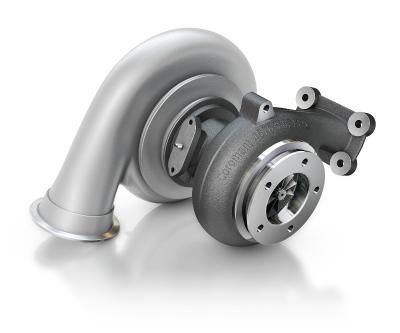
Sandvik Coromant has introduced its M612 facemill, a product engineered specifically for the roughing stainless steel turbo housings. The tool’s positive geometry has the effect of providing a smoother cutting action, which helps machine shops to eliminate vibration. In turn, higher metal-removal rates can reportedly be achieved, leading to shorter cycles. The geometry and edge-line quality also help ensure reliability and an increased number of components per insert.
“Stainless is becoming a more popular material choice for turbo housings over the conventional cast iron as a result of its material properties that help improve resistance to exhaust gas temperatures of up to 1300° C, as well as corrosion,” says Jacques Gasthuys, automotive application engineer at Sandvik Coromant. “Approximately 50 million turbo chargers are produced every year—cast iron and stainless—but the cost of machining stainless is up to 20 times higher as these operations are often characterized by extremely short and irregular insert tool life, as well as uneven wear. Our goal was to develop a strong cutter able to help lower component costs.”
The main challenge in roughing turbo exhaust housings is the complex shape of these thin-walled components and their intricate clamping, which together make for a vibration-prone operation. The new M612 facemilling cutter is purpose-designed to help overcome this issue. Its positive geometry provides smooth cutting action, which lowers power consumption and eliminates vibrations in roughing operations. This permits greater metal removal and quicker cycle times, which in combination with 12 cutting edges, six on both sides, contributes to lower cost per component. The choice of round inserts also adds flexibility for machine shops, while the insert indexation interface delivers both accuracy and repeatability.
In a user case example using grade GC4240 inserts to rough a stainless turbo exhaust housing, the use of an M612 facemill in place of a competitor cutter allowed spindle speed to be increased from 212 to 273 rev/min, cutting speed to be raised from 70 to 90 m/min (230 to 295 ft/min) and feed to be increased from 0.13 to 0.18 mm (0.005 to 0.007 inch). At the same 2.5 mm (0.098 inch) depth of cut, the result of the trial showed that the M612 facemill reduced machining time per component by 27 percent, while tool life increased by as much as 172 percent.
Contact Details
Related Glossary Terms
- cutting speed
cutting speed
Tangential velocity on the surface of the tool or workpiece at the cutting interface. The formula for cutting speed (sfm) is tool diameter 5 0.26 5 spindle speed (rpm). The formula for feed per tooth (fpt) is table feed (ipm)/number of flutes/spindle speed (rpm). The formula for spindle speed (rpm) is cutting speed (sfm) 5 3.82/tool diameter. The formula for table feed (ipm) is feed per tooth (ftp) 5 number of tool flutes 5 spindle speed (rpm).
- depth of cut
depth of cut
Distance between the bottom of the cut and the uncut surface of the workpiece, measured in a direction at right angles to the machined surface of the workpiece.
- facemill
facemill
Milling cutter for cutting flat surfaces.
- facemilling
facemilling
Form of milling that produces a flat surface generally at right angles to the rotating axis of a cutter having teeth or inserts both on its periphery and on its end face.
- feed
feed
Rate of change of position of the tool as a whole, relative to the workpiece while cutting.

